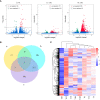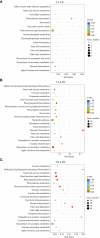Drought stress-induced the formation of heteromorphic leaves of Populus euphratica Oliv: evidence from gene transcriptome
- PMID: 37351211
- PMCID: PMC10282185
- DOI: 10.3389/fpls.2023.1194169
Drought stress-induced the formation of heteromorphic leaves of Populus euphratica Oliv: evidence from gene transcriptome
Abstract
Populus euphratica Oliv., a dominant species of arid desert community, grows heteromorphic leaves at different crown positions. Whether heteromorphic leaves are a strategy of plant adaptation to drought stress is rarely reported. This study sequenced the transcriptome of three typical heteromorphic leaves (lanceolate, ovate and broad-ovate leaves) of P. euphratica, and measured their drought stress. We wanted to reveal the molecular mechanisms underlying the formation of heteromorphic leaves. Drought stress was increased significantly from lanceolate to ovate to broad-ovate leaves. Gene ontology (GO) and KEGG enrichment analysis showed that the MADs-box gene regulated the expression of peroxidase (POD) in the phenylpropane biosynthetic pathway. The up-regulated expression of the chalcone synthase (CHS) gene in broad-ovate leaves significantly activated the flavonoid biosynthetic pathway. In the process of leaf shape change, the different expressions of homeodomain leucine zipper (HD-ZIP) among the three heteromorphic leaves had potential interactions on the AUX and ABA pathways. The expression of Sucrose phosphate synthase (SPS) and sucrose synthase (SUS) increased from lanceolate to broad-ovate leaves, resulting in a consistent change in starch and sucrose content. We concluded that these resistance-related pathways are expressed in parallel with leaf formation genes, thereby inducing the formation of heteromorphic leaves. Our work provided a new insights for desert plants to adapt to drought stress.
Keywords: RNA-seq; arid desert; drought stress; genetic expression; heteromorphic leaves.
Copyright © 2023 Xu, Liu, Huang, Li, Dai and Yang.
Conflict of interest statement
The authors declare that the research was conducted in the absence of any commercial or financial relationships that could be construed as a potential conflict of interest.
Figures








Similar articles
-
The Identification and Characterization of the PeGRF Gene Family in Populus euphratica Oliv. Heteromorphic Leaves Provide a Theoretical Basis for the Functional Study of PeGRF9.Int J Mol Sci. 2024 Dec 25;26(1):66. doi: 10.3390/ijms26010066. Int J Mol Sci. 2024. PMID: 39795925 Free PMC article.
-
Hydraulic constraints determine the distribution of heteromorphic leaves along plant vertical height.Front Plant Sci. 2022 Sep 29;13:941764. doi: 10.3389/fpls.2022.941764. eCollection 2022. Front Plant Sci. 2022. PMID: 36275510 Free PMC article.
-
iTRAQ-based proteomic analysis of heteromorphic leaves reveals eco-adaptability of Populus euphratica Oliv.J Plant Physiol. 2022 Apr;271:153644. doi: 10.1016/j.jplph.2022.153644. Epub 2022 Feb 10. J Plant Physiol. 2022. PMID: 35219031
-
Conjoint Analysis of Genome-Wide lncRNA and mRNA Expression of Heteromorphic Leavesin Response to Environmental Heterogeneityin Populus euphratica.Int J Mol Sci. 2019 Oct 17;20(20):5148. doi: 10.3390/ijms20205148. Int J Mol Sci. 2019. PMID: 31627402 Free PMC article.
-
Progress in studying heteromorphic leaves in Populus euphratica: leaf morphology, anatomical structure, development regulation and their ecological adaptation to arid environments.Plant Signal Behav. 2021 Apr 3;16(4):1870842. doi: 10.1080/15592324.2020.1870842. Epub 2021 Jan 11. Plant Signal Behav. 2021. PMID: 33427562 Free PMC article. Review.
Cited by
-
The Role of Phytohormones in Mediating Drought Stress Responses in Populus Species.Int J Mol Sci. 2025 Apr 19;26(8):3884. doi: 10.3390/ijms26083884. Int J Mol Sci. 2025. PMID: 40332819 Free PMC article. Review.
-
Differential effects of cow dung and its biochar on Populus euphratica soil phosphorus effectiveness, bacterial community diversity and functional genes for phosphorus conversion.Front Plant Sci. 2023 Sep 14;14:1242469. doi: 10.3389/fpls.2023.1242469. eCollection 2023. Front Plant Sci. 2023. PMID: 37780507 Free PMC article.
References
-
- Alaoui-Sossé B., Ricaud S., Barnola P., Dizengremel P. (1996). Rhythmic growth and carbon allocation in Quercus robur. sucrose metabolizing enzymes in leaves. Physiologia Plantarum. 96 (4), 667–673. doi: 10.1111/j.1399-3054.1996.tb00241.x - DOI
LinkOut - more resources
Full Text Sources

